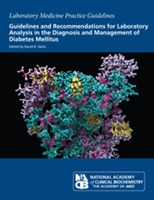 The National Academy of Clinical Biochemistry
The National Academy of Clinical Biochemistry
Laboratory Medicine Practice Guidelines
Guidelines and Recommendations for Laboratory Analysis in the Diagnosis and Management of Diabetes Mellitus
Publication Date: 2011
Multiple laboratory tests are used in the diagnosis and management of patients with diabetes mellitus. The quality of the scientific evidence supporting the use of these assays varies substantially. An expert committee compiled evidence-based recommendations for the use of laboratory analysis in patients with diabetes. A new system was developed to grade the overall quality of the evidence and the strength of the recommendations. In addition to the long-standing criteria based on measurement of venous plasma glucose, diabetes can be diagnosed by demonstrating increased hemoglobin A1c (Hb A1c) concentrations in the blood. Monitoring of glycemic control is performed by the patients measuring their own plasma or blood glucose with meters and by laboratory analysis of Hb A1c. The potential roles of noninvasive glucose monitoring, genetic testing, and measurement of autoantibodies, urine albumin, insulin, proinsulin, C-peptide, and other analytes are addressed.
Guidelines Committee:
- David B. Sacks, M.B., Ch.B., Chair
- Mark Arnold, PhD
- George L. Bakris, M.D.
- David E. Bruns, M.D.
- Andrea Rita Horvath, M.D., Ph.D.
- Sue M. Kirkman, M.D.
- Ake Lernmark, M.D.
- Boyd E. Metzger, M.D.
- David Nathan, M.D.